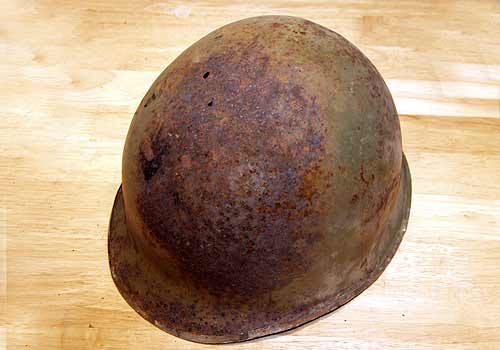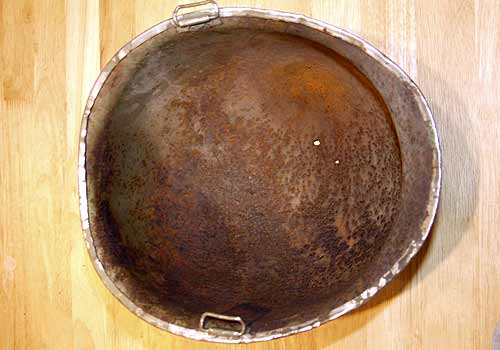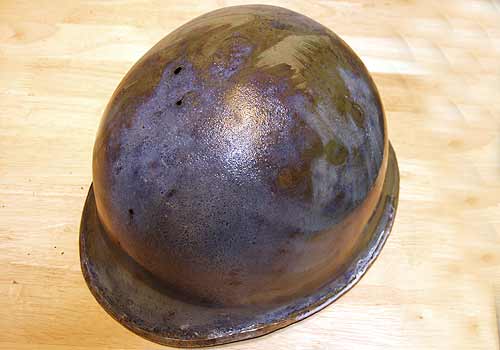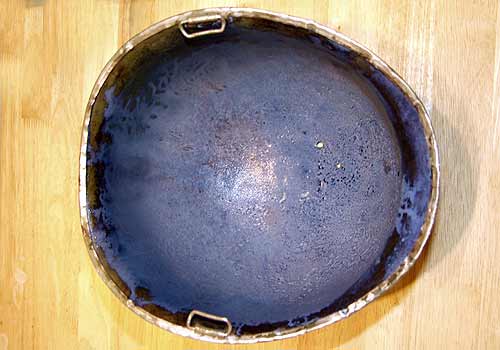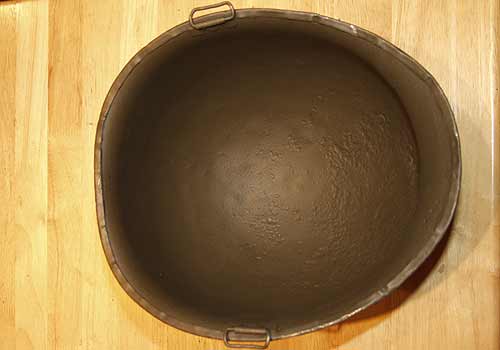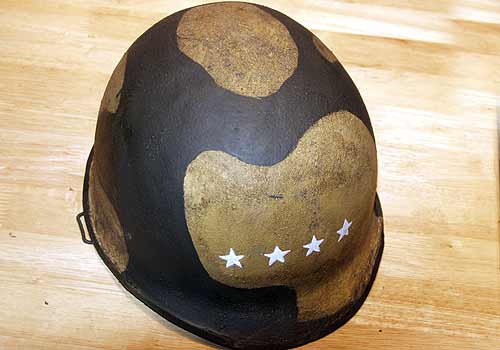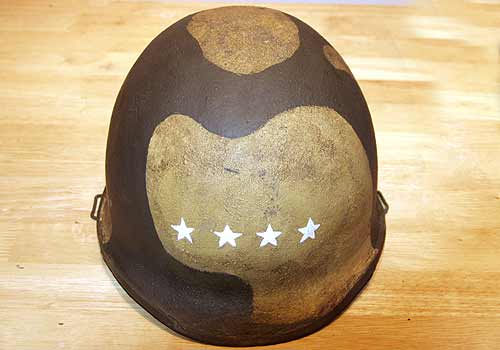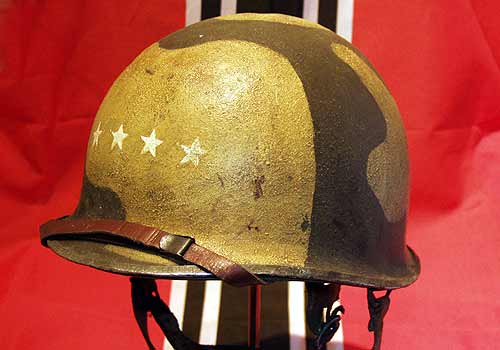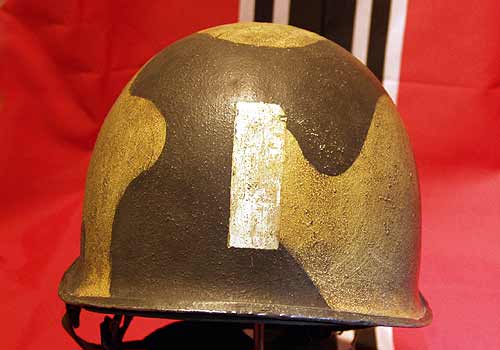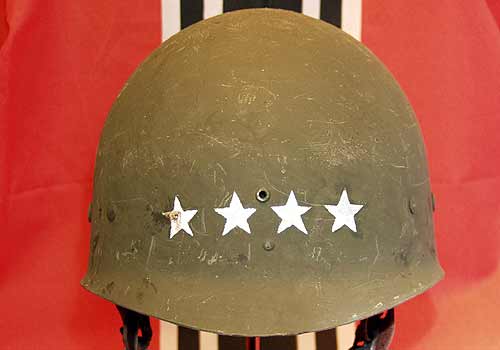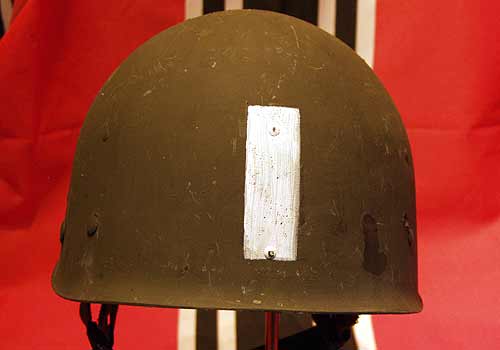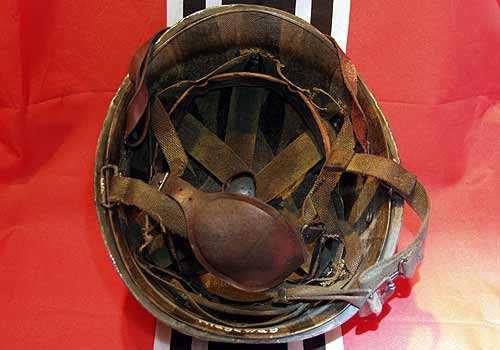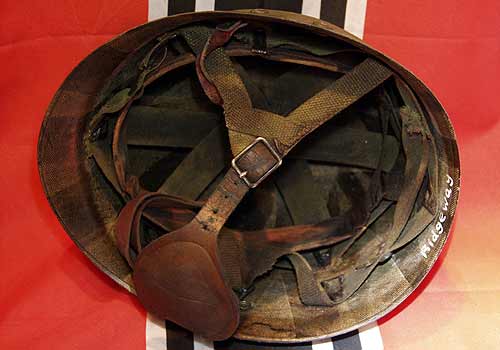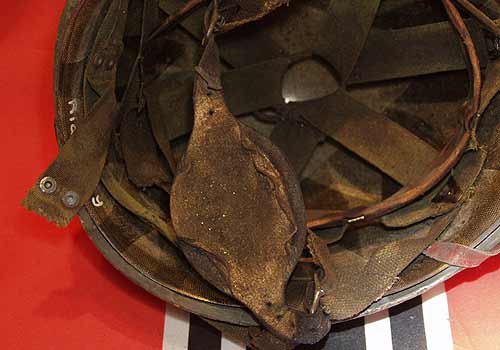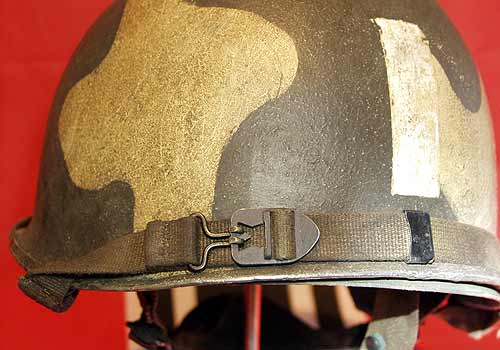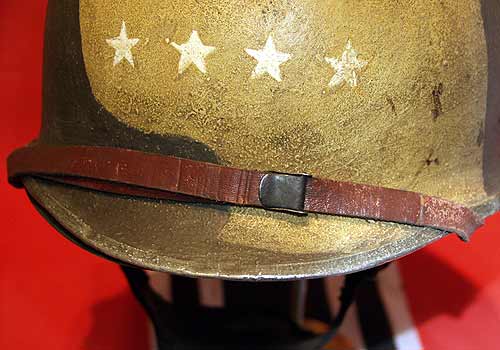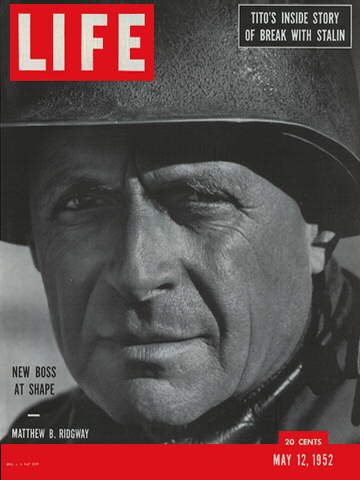 |
 |
 |
 |
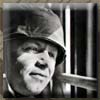 |
| Menu: |
| Home |
| Store |
| Buying |
| X-Sales |
| Info |
| FAQ's |
| Contact |
| Links |
WW2 M1C American 82nd Airborne Helmet Well my interest in WW2 helmets has now lead me to the USA WW2 Paratrooper Helmet. So I thought since I'm going to restore and replicate some of them, I might as well place some of the details on my site! You wont get the full 'trade secrets' but you'll get the idea how to do it! From a standard M1 WW2 helmet I want to recreate a WWII M1C Swivel Bail Paratrooper Helmet. The helmet I have chosen has seen better days and has been rotting away outside for years. I want to restore it to its former glory and enhance it by converting to a M1C paratrooper helmet! Purchase your inexpensive WW2 M1 Helmet shell. These can be found on many common online auction sites for approx. £20 plus, depending on quality. All American WW2 Helmets were the same size so it doesn't matter what one you purchase. The cheaper versions are swivel bail and very rusted, while the expensive ones are fixed bail, front seam and in very good condition. It doesn't matter about rust or dents, these can generally be removed or fixed to an acceptable standard.Here is a picture of one in its original state. |
| If the shell is rusted you need to sand down the inside and outside by hand. If you can use a power tool so much the better but I have found that manual efforts give the best finish! In the case of most helmets you don't need to treat light rusting. In this case its pretty heavy rusting so ideally treat with a rust inhibitor. See the two pictures below. |
| After treating the helmet you need to fill in any rusted holes. You can do this with either a welding device or standard car metal filler. Don't use household plaster filler as I have seen on some helmets! It falls out even after medium strength handling. You then need to either grind or hand sand the filled holes. Pic 5 below shows the result of filling and sanding. |
Once you have filled & sanded the holes you can then apply the cork. I'm afraid this is one trade secret I can't pass on. Suffice to say that is not hard to do if you are good at crafts or DIY! Once applied, you can paint both the inside and outside. I use USA Olive Drab, a very close match to originals, if not identical! I use a UK supplier but of course you can get this in many parts of the world. You will notice I have not filled in the deep pitted holes on the inside - see Pic 6 below. There is one reason for this, I like to leave something original about the helmet and leaving the inside like this helps to confirm its original history. Most of my clients are very happy with this approach. You can of course fill any deep holes in the same way as the outer holes. |
Once the helmet has been corked and painted again, you then need to decide what M1 helmet you are going to replicate. Since this was one of my first and certainly the most rusted helmet I have received to date I have decide to make this one one of the 'Kings' of helmets. I'm not going to say what it is, I'll leave that to the end, but suffice to say it will be a WW2 M1C Paratrooper helmet. So once decided on the unit of choice its time to paint it up if necessary. This helmet was painted in this scheme in 1943 and remained this way till it ended up in a collection. It is now in a museum. I have tried to replicate the camouflage pattern to the original helmet, looking at the picture below some of the Airborne enthusiasts will start to recognise this helmet. This is the paint 'hot off the press' - it was still wet when I took the photograph, there is lots of ageing and replicating still to do! See Pic 7 below. |
The helmet has been painted very roughly in the scheme required, now you need to tighten up the painting and apply the decals. Before you do this it is a good idea to age the helmet as this can often obliterate the decals and markings! I'm not going to tell you how to age the helmet, suffice to say it does take time and patience to ensure it looks looks original! Have a look at Pic 8 below, it is in its first stages of ageing and the decals have been applied. Now this helmet is trying to recreate an original helmet in both first glance and close up, so the camouflage needs to be spot on. Notice how it has changed from Pic 7. Also notice how the stars are un-aged! |
| So I'm wondering if anyone has guessed who this helmet belonged to? I think the stars should narrow it down a bit! Pic 9 below is a rear view and again the officers strip is un-aged. |
| Notice how the strip is not perfect, it has wear points across its outline and edges. This is because the original helmet had this. It is easier to do this now before ageing the strip. This helmet is a straight replica of a famous Airborne helmet and this every details need to be as close to the original as possible! Pic 10 below shows another shot of the front decals. |
| The pictures below now shows the helmet shell finished and aged. Notice how the stars are now darker and worn looking as is the officers stripe at the rear. |
| Now that the shell ageing is complete it is time to move onto the liner. The liner is a composite post WW2 liner which has been converted to a M1C liner. Notice in the two pictures below I have aged the markings less as these would not have been exposed to general wear and tear as much as the shell. |
| Following on from the outer M1-C outer liner the inner liner has been fully fitted out with Paratrooper chin strap, leather chin strap and leather 'A' frame webbing a Paratrooper chin cup. Notice how all of this has been aged. If you are lucky enough to see the original of this helmet you will notice how I have recreated the worn folds of the chamois leather chin cup insert! |
| Notice the wear to the buckles, chin strap, leather and the webbing material. There is a long mark on the chin strap, this is identical to the original helmet! |
| The chamois is well used and folded back due to its age. Remember, this helmet is 60+ years old. Again, the folds recreate the original helmet. For the observant people out there you will notice a hand painted name on the rear of the liner. If you know your airborne history, you should now know who this helmet belonged to! |
| So that's about it! the two pictures below are close ups showing the detail of the helmet. I hope that you have enjoyed reading this transformation story from rusted out shell to M1C Airborne helmet worn by General Matthew Ridgway in WW2 and Korea. He had this helmet painted for the Italian campaign in 1943 and did not change it and it remained this way throughout his military career. |
| The Story of General Ridgway : |
Pic 19 - General Ridgway |
In August 1942, Ridgway was promoted to major general and was given command of the 82nd Airborne Division, upon Omar N. Bradley's assignment to the 28th Infantry Division. The division was selected to become one of the army's five airborne divisions, based in no small part on Ridgway 's skill as a trainer, and flexibility of thinking compared to his peers. At that time, the airborne division concept was an experiment for the US Army. Ridgway helped plan the airborne invasion of Sicily in July 1943, and commanded the 82nd in combat there. During the planning for the invasion of the Italian mainland, the 82nd was tasked with taking Rome by coup-de-main in Operation Giant II. Ridgway strongly objected to this unrealistic plan, which would have dropped the 82nd on the outskirts of Rome in the midst of two German heavy divisions. The operation was cancelled only hours before launch. In 1944, Ridgway helped plan the airborne operations on Operation Overlord. In the Normandy operations, he jumped with his troops, who fought for 33 days in advancing to St-Sauveur near Cherbourg (St Sauveur le Vicomte, in the middle of the Cotentin Peninsula, was liberated on June 14th 1944). In September of 1944, Ridgway was given the command of the XVIII Airborne Corps and led his troops into Germany. In June 1945 he was promoted to lieutenant general. He jumped with the 17th Airborne Division in Operation Varsity and was wounded in the shoulder by German grenade fragments on March 24, 1945. At war's end, Ridgway was on a plane headed for a new assignment in the Pacific theater, under General of the Army Douglas MacArthur, with whom he had served while a captain at the United States Military Academy at West Point. He was a command at Luzon for some time in 1945, before being given command of the US forces in the Mediterranean Theater, also gaining the title of Deputy Supreme Allied Commander, Mediterranean. From 1946 to 1948, he served as the U.S. Army representative on the military staff committee of the United Nations. He was given command of Caribbean Command, controlling U.S. forces in the Caribbean, in 1948, and in 1949 was assigned to the position of Deputy Chief of Staff for administration under Army Chief of Staff General J. Lawton Collins. Ridgway 's most important command assignment occurred in 1950, upon the death of Lieutenant General Walton Walker. Upon Walker's death, he received command of the 8th US Army, which had been deployed in South Korea upon the invasion of North Korea in June of that year. At the time Ridgway was serving on the Army staff in the Pentagon as deputy chief of staff for operations and administration, yet he was knowledgeable about conditions in Korea and the Far East, and had a strong and dynamic personality. Both proved invaluable for the task ahead. When Ridgway took command, the army was still in a tactical retreat, after a strong foray into North Korea had been met with an unexpected and overwhelming Communist Chinese advance. Ridgway 's success in turning Eighth Army’s morale around, using little more than a magnetic personality and bold leadership, is still a model for the Army for how the power of leadership can dramatically change a situation. Perhaps another reason he was chosen was because Ridgway was not fazed by the Olympian demeanor of General Douglas MacArthur, then overall commander of UN forces in Korea. MacArthur in turn gave Ridgway a latitude in operations he had not given his predecessor. After Ridgway landed in Tokyo on Christmas Day 1950 to discuss the operational situation with MacArthur, the latter assured his new commander that the actions of Eighth Army were his to conduct as he saw fit. Ridgway was encouraged to retire to successive defensive positions, as was currently under way, and hold Seoul as long as he could, but not if it meant that Eighth Army would be isolated in an enclave around the city. In a foreshadowing of his aggressive nature, Ridgway asked specifically that if he found the combat situation "to my liking" whether MacArthur would have any objection to "my attacking"? MacArthur answered, "Eighth Army is yours, Matt. Do what you think best." Upon taking control of the battered Eighth Army, one of Ridgway 's first acts was to restore soldiers' confidence in themselves. To accomplish this he aggressively went about finding other leaders in Eighth Army who were not defeatist or defensive oriented, despite the hard knocks of November and December, and put them in charge. He was quick to reward commanders who shared his sentiments, and just as quick to relieve those officers at any level who did not. For example, during one of his first briefings in Korea at I Corps, Ridgway sat through an extensive discussion of various defensive plans and contingencies. At the end he asked the startled staff where their attack plans were. The corps G–3 (operations officer) responded that he had no such plans. Within days I Corps had a new G-3 and the message went out: Ridgway was interested in taking the offensive. In furtherance of this goal, he established a plan to rotate out those division commanders who had been in action for six difficult months, and replace them with fresh leaders who would be more interested in attack and less in defense. He also sent out guidance to commanders at all levels that they were to spend more time at the front lines and less in their command posts in the rear. The men had to see their commanders if they were to have confidence that they had not been forgotten. All these positive leadership steps had a dramatic effect almost from the first. Eighth Army was in Korea to stay. Still, with the entry of China, the makeup of the Korean War had changed. Political leaders, in an attempt to prevent expansion of the war, would not allow UN forces to bomb the supply bases of the Chinese Army that were in China, nor the bridges across the Yalu river. Thus the American Army had to move from being always aggressive, to fighting protective, delaying actions until the supply lines of China had been extended enough to allow equilibrium. Under Ridgway 's leadership, the Chinese offensive was slowed and finally brought to a halt at the battles of Chipyong-ni and Wonju. He then led his troops in a subsequent counter-offensive in the spring of 1951. When General Douglas MacArthur was relieved of command by President Harry Truman in April, Ridgway was promoted to full general, assuming command of United Nations forces in Korea. As commanding general in Korea, Ridgway gained the nickname, "Old Iron Tits," for his habit of wearing hand grenades attached to his load-bearing equipment at chest level. {Photographs however show he only wore one grenade on one side of his chest; the so-called "grenade" on the other side was in fact a first-aid packet}. Military historians generally credit Ridgway with leadership that helped restore the Eighth Army as an aggressive fighting force, allowing it combat the overwhelming masses of troops from the People's Republic of China to a standstill, and eventually driving them out of South Korea across the 38th parallel.[citation needed] Ridgway 's personal example, as well as his thorough knowledge of basic military operational principles, set a leadership standard few in US Army history could match. In May 1952, Ridgway replaced General Dwight D. Eisenhower as the Supreme Allied Commander, Europe (SACEUR). However, he upset other European military leaders by surrounding himself with American staff, and returned to the U.S. to replace General Collins as the Chief of Staff of the United States Army. President Eisenhower asked for his assessment of US military involvement in Vietnam in conjunction with the French. In response, Ridgway prepared a comprehensive outline of the massive commitment that would be necessary, which dissuaded the President from intervening. However, the experience sorely tested the relationship Ridgway had enjoyed during World War II with Eisenhower, who wanted to intervene, and he retired from the US Army in 1955, succeeded in the Chief of Staff post by his one time 82nd Airborne Division Chief of Staff Maxwell D. Taylor. In the opinion of a number of military historians, Ridgway 's stand as Chief of Staff delayed US intervention in Vietnam for around ten years. Ridgway had been forced to retire earlier than he planned, but he was secure in the belief he had served his nation to the best of his ability. The year after his retirement, he published his autobiography, Soldier: The Memoirs of Matthew B. Ridgway Ridgway 's success in the military was not matched by success in his personal life. He married three times. For a while, he held the position of chairman of the board of trustees of the Mellon Institute in Pittsburgh, Pennsylvania. According to his friends and colleagues, Ridgway was never the same after his son died in a camping accident in 1971, becoming increasingly depressed and morose. On 5 May 1985 he was a key player in the controversial Ronald Reagan visit to Kolmeshöhe Cemetery near Bitburg, when former Luftwaffe ace Johannes Steinhoff in an unscheduled act firmly shook his hand in an act of reconciliation between the former foes. Ridgway died at his home in the Pittsburgh suburb of Fox Chapel at age 98 in March 1993 of cardiac arrest, holding permanent rank of General in the United States Army. He is buried at Arlington National Cemetery, and a street "Ridgway Court" was named after him in Pittsburgh, the avenue serves as the entrance to the Soldiers and Sailors National Military Museum and Memorial located in the city's University District. |
Pic 20- General Ridgway - Life Magazine wearing his Helmet |
| For those who want to know where his helmet now resides - click here! |

